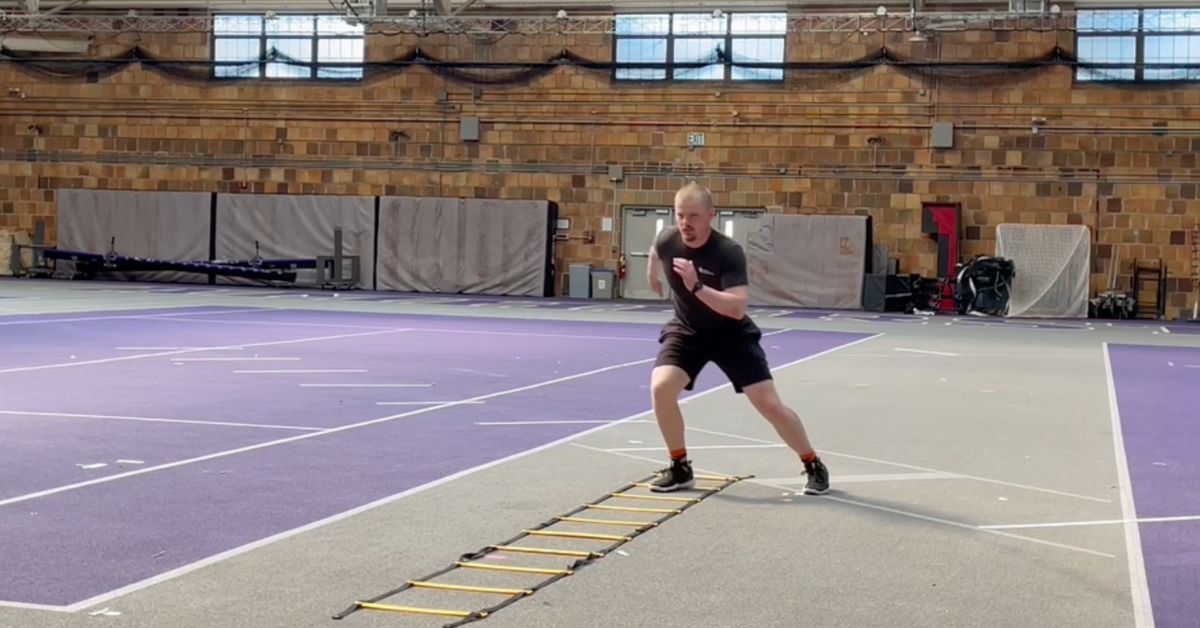A common theme throughout the strength and conditioning field revolves around the purpose, if any, that “speed” or “agility” ladders serve. I used quotation marks around the terms “speed” and “agility” because we know that ladders do not inherently train speed or agility in athletes. So, what can this attention-grabbing piece of equipment help with? Before we get into some potential benefits of using what is often deemed silly, let us first look at what these ladders do NOT do.
“Speed” ladders do not directly improve speed. Speed training can be broken down into:
- Technical work
- Acceleration work
- Max velocity work.
Within each of these categories, there are also primary, secondary, and tertiary speed training exercises. Primary exercises directly improve speed by specifically training with the appropriate speeds and technique. An example of a primary acceleration exercise is a pushup start.
Secondary exercises assist in speed training, but the speed or technique might be slightly altered. An example of a secondary acceleration exercise is a heavy resisted sprint: a sled pull so heavy that sprinting technique is broken down. The athlete is still receiving force production training that can benefit acceleration, but with a reduction in specificity due to technical breakdown.
Lastly, tertiary exercises complement the positions and characteristics of speed training, but in a much more general sense. An example of a tertiary acceleration exercise might be a broad jump: a plyometric exercise that targets horizontal force production, but which looks and feels nothing like sprinting. All of these types of exercises have their place in training, and although ladders often require athletes to move at higher speeds, the drills primarily used with ladders are very unlike sprinting.
“Agility” ladders also do not directly improve agility. Agility is defined by the NSCA as “the skills and abilities needed to change direction, velocity, or mode in response to a stimulus” (Haff & Triplett, 2016). Like with speed training, the ladder does not encourage the use of proper mechanics for changing direction and becoming more agile. Furthermore, most ladder drills do not incorporate changing direction, velocity, or mode in response to a stimulus, which is a key component of agility.
So, Where Do Ladders Fit into Athletic Development?
Here are four areas where athletes may benefit from the use of ladders in training.
1. Warm-ups
Ladder drills can be beneficial in raising the heart rate of your athletes. In following the RAMP protocol (Haff & Triplett, 2016), the warmup should begin with activities that elevate “body temperature, heart rate, respiration rate, blood flow, and joint fluid viscosity via low-intensity activities.” The ladder can certainly accomplish all of these when done appropriately.
[vimeo 960532064 w=800]
Video 1. Two-foot and alternating lead foot.
[vimeo 960534724 w=800]
Video 2. Hopscotch—try to imagine the ceiling just above your head, and keep the same height the entire time. No bouncing up and down!
Additionally, sticking with the RAMP protocol, the ladder may also serve to potentiate the nervous system for subsequent training. In fact, 2023 NFL Offensive Player of the Year, Christian McCaffrey has a video in which he discusses beginning his training sessions with the ladder. In the video, he explains that he uses the ladder to get his “feet warm,” his “hips moving,” and “brain synced up” with his body. Incorporating ladder drills in this way can provide a similar stimulus to more traditional track-based drills, like A-marches and A-skips, giving coaches another tool in their toolbox for athlete development.
[vimeo 960536166 w=800]
Video 3. Always popular, “The Icky Shuffle.”
2. Coordination/Timing
Using the ladder in your warmups can not only serve the purpose of warming the athlete up, but you might even be able to get some coordination improvements as well, depending on the training age of the athlete. Younger or newer athletes will certainly experience rapid improvements in their motor control and coordination.
[vimeo 960541123 w=800]
Video 4. Hip Switch and Snake: Encourage your athletes to pace themselves here. These drills are not about speed, but rather coordination and timing of contractions.
[vimeo 960542591 w=800]
Video 5. In/Out Series with multiple variations.
Challenging the body with ladder drills done at faster paces can help improve the rate coding ability of your body (Enoka & Duchateau, 2017). Rate coding is the speed at which neural impulses are conducted to the individual motor units within the muscle (Deschenes, 1989)—this can be key for enhancing Rate of Force Development (Enoka & Duchateau, 2017), which is critical for improving sport performance (Iguchi et al., 2011; Sheppard et al., 2008). Some of the ladder drills shown above, like the “Lateral 1 In, 2 Out” or the “Snake” are examples of drills that can help improve rhythm and coordination in your athletes.
3. Extensive Plyometric Contacts
Using the ladder can also increase the number of extensive plyometric contacts within a session. Although extensive plyometrics may not be as effective as more intensive plyometrics at training Rate of Force Production, they still serve a purpose in helping athletes develop adequate tissue tolerance and capacity for handling more intense plyometrics.
[vimeo 960544516 w=800]
Video 6. Scissors. Cue opposite arm action with your athletes: the left arm moves with the right leg and vice-versa.
This might be most beneficial during a general physical preparation (GPP) block, to help prepare the athletes for more intense movements later on. Additionally, training our athletes to repeat submaximal plyometric efforts can also be critical for sports that require more endurance and repeated efforts, such as soccer. Each drill shown in this article can be strung together for a quick ladder series before your training sessions, and you can add sets to the series as the weeks go on and your athletes build up a plyometric base.
Although extensive plyometrics may not be as effective as more intensive plyometrics at training Rate of Force Production, they can still help athletes develop tissue tolerance and capacity for handling more intense plyometrics. Share on X4. Engagement
“You need to get him/her going on the agility ladder this offseason.” This is a common suggestion that I hear from parents, athletes, and coaches alike. Ladders attract a lot of attention, especially when elite athletes are completing the drills smoothly and gracefully.
Many athletes acknowledge the significance of being able to execute their movements on the court or field with fluidity, and recognize the ladder as a way of improving this quality. This engagement factor of using ladders should not be overlooked.
[vimeo 960546090 w=800]
Video 7. High Knee Crossover & Speed Crossover. The goal here is speed! You can drive intent by putting two ladders side by side and having athletes race against each other.
Athletes want to use the ladders (though often for misguided reasons), and this desire alone can be enough to drive intent, and bring about the aforementioned improvements to timing and coordination. Of course, as with any training plans, it is important to inform athletes and coaches of the WHY behind everything you do, and drive the education of your athletes.
[vimeo 960547316 w=800]
Video 8. Carioca pattern.
Taking it to the Training Ground
Returning to the opening section—where I discussed primary, secondary, and tertiary exercises for training speed and agility—you might classify ladder drills as tertiary exercises for accomplishing this goal. Increasing rate coding and coordination between the brain and the rest of the body can indirectly increase speed and agility, as well as athletic performance.
Are there more specific and more beneficial drills for training speed and agility? Absolutely. By no means should ladders REPLACE sprinting drills or change of direction/agility drills, says @coachtj_cahill. Share on XAre there more specific and more beneficial drills for training speed and agility? Absolutely. By no means should ladders replace sprinting drills or change of direction/agility drills. But are there appropriate uses of ladder drills in training? Of course. By adding ladders to your coaching toolbox, you can spice up your warm-ups, reap some enhanced coordination benefits, add in some extensive plyometric contacts, and drive greater intent from your athletes.
[freelap-share]
References
Deschenes, M. (1989). Short review: Rate coding motor unit recruitment patterns. Journal of Strength and Conditioning Research, 3(2), 34-39.
Enoka, R.M., & Duchateau, J. (2017). Rate coding and the control of muscle force. Cold Spring Harbor Perspectives in Medicine, 7, 1-12.
Haff, G. G., & Triplett, N. T. (2016). Essentials of Strength Training and Conditioning (4th ed.). Human Kinetics.
Iguchi, J., Yamada, Y., Ando, S., Fujisawa, Y., Hojo, T., Nishimura, K., Kuzuhara, K., Yuasa, Y., & Ichihashi, N. (2011). Physical and performance characteristics of Japanese division I college football players. Journal of Strength and Conditioning Research, 25(12), 3368-3377.
Sheppard, J. M., Cronin, J. B., Gabbett, T. J., McGuigan, M. R., Etxebarria, N., & Newton, R. U. (2008). Relative importance of strength, power, and anthropometric measures to jump performance of elite volleyball players. Journal of Strength and Conditioning Research, 22(3), 758-765.






